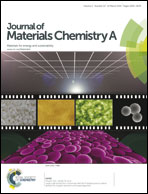Donor–spacer–acceptor monodisperse conjugated co-oligomers for efficient single-molecule photovoltaic cells based on non-fullerene acceptors†
Abstract
The current challenges for efficient bulk heterojunction (BHJ) organic photovoltaics (OPVs) based on organic/polymeric (non-fullerene) acceptors involve difficult control of neat phase separation in the nanoscale, severe geminate charge recombination, etc. Herein, a new molecular design concept, that is to construct donor–spacer–acceptor (D–S–A) co-oligomers with self-assembly properties, is proposed in order to realize ideal film morphology and manipulate the exciton dissociation and geminate charge recombination processes simultaneously. Three D–S–A co-oligomers, i.e.F5T8P-C2, F5T8P-C4 and F5T8P-C6 with oligo(fluorene-alt-bithiophene), perylene diimide (PDI) and alkyl as D-, A- and S-segments, respectively, were synthesized. All three D–S–A co-oligomers can form D–A alternating lamellar nanostructures with periods of ∼15 nm, an ideal nanostructure for BHJ OPVs. Compared to D–A co-oligomer F5T8-epP in which the D- and A-segments are directly connected without the alkyl spacer, the D–S–A co-oligomers not only show higher electron mobilities due to closer packing of PDI moieties, but also exhibit longer lifetimes of the charge-transfer states that can potentially restrain the geminate charge recombination and improve the charge generation efficiency. Accordingly, the single-molecule photovoltaic cells based on the D–S–A co-oligomers exhibit an improved fill factor of 0.47 and a high open-circuit voltage of 1.04 V. In particular, an external quantum efficiency of ∼65%, which is the highest for BHJ OPVs based on non-fullerene acceptor materials, has been demonstrated. By further extending the absorption onset of D–S–A co-oligomers to ∼600 nm, a single-molecule photovoltaic device with a power conversion efficiency of 2.70% has been fabricated. These results prove that high-efficiency BHJ OPVs based on non-fullerene acceptors are achievable if both the film morphology of the D–A blend and D–A interfaces are suitably manipulated.


 Please wait while we load your content...
Please wait while we load your content...